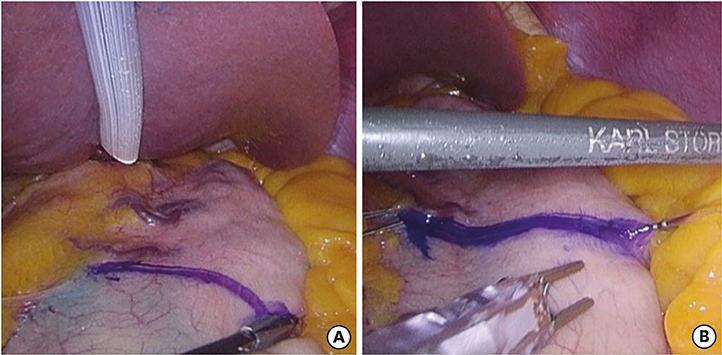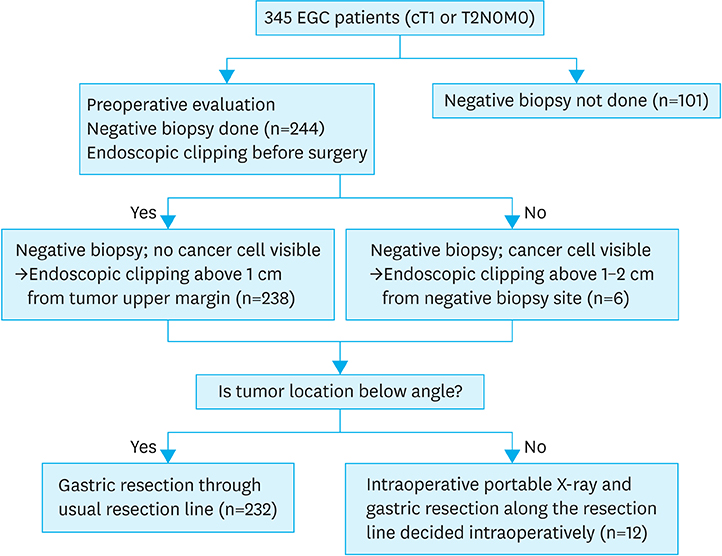J Gastric Cancer.
2017 Sep;17(3):220-227. 10.5230/jgc.2017.17.e25.
A Promising Method for Tumor Localization during Total Laparoscopic Distal Gastrectomy: Preoperative Endoscopic Clipping based on Negative Biopsy and Selective Intraoperative Radiography Findings
- Affiliations
-
- 1Department of Surgery, Kosin University College of Medicine, Busan, Korea. kwseo.surg@kosin.ac.kr
- 2Division of Gastroenterology, Department of Internal Medicine, Kosin University College of Medicine, Busan, Korea.
- KMID: 2389826
- DOI: http://doi.org/10.5230/jgc.2017.17.e25
Abstract
- PURPOSE
Precise localization of tumors and creation of sufficient proximal resection margins are complicated processes during total laparoscopic distal gastrectomy (TLDG) for clinical T1/T2 gastric cancers. Various solutions to this problem have also yielded many disadvantages. In this study, we reviewed a preoperative endoscopic clipping method based on the results of negative biopsy and selective intraoperative radiography.
MATERIALS AND METHODS
A retrospective review of 345 consecutive patients who underwent TLDG and preoperative endoscopic clipping for tumor localization was conducted. During preoperative endoscopy, the endoscopists performed negative biopsies just 1-2 cm selectively above the tumor's upper limit. After confirming the biopsy results, endoscopic metal clips were applied just proximal to the negative biopsy site the day before surgery. Selective intraoperative tumor localization using portable abdominal radiography was performed only when we could not ensure a precise resection line.
RESULTS
Negative biopsy was performed in 244 patients. Larger tumor size (P=0.008) and more distally located tumors (P=0.052) were observed more frequently in the negative biopsy group than in the non-negative biopsy group. The non-negative biopsy group had significantly higher frequencies of differentiated tumor types than the negative biopsy group (P=0.003). Of the 244 patients who underwent negative biopsies, 6 had cancer cells in their biopsy specimens. We performed intraoperative radiography in 12 patients whose tumors had difficult-to-determine proximal margins. No tumors were found in the proximal resection margins of any patients.
CONCLUSIONS
Our tumor localization method is a promising and accurate method for securing a sufficient resection margin during TLDG.
MeSH Terms
Figure
Reference
-
1. Kim MG, Kim KC, Kim BS, Kim TH, Kim HS, Yook JH, et al. A totally laparoscopic distal gastrectomy can be an effective way of performing laparoscopic gastrectomy in obese patients (body mass index ≥30). World J Surg. 2011; 35:1327–1332.2. Kim HI, Hyung WJ, Lee CR, Lim JS, An JY, Cheong JH, et al. Intraoperative portable abdominal radiograph for tumor localization: a simple and accurate method for laparoscopic gastrectomy. Surg Endosc. 2011; 25:958–963.3. Xuan Y, Hur H, Byun CS, Han SU, Cho YK. Efficacy of intraoperative gastroscopy for tumor localization in totally laparoscopic distal gastrectomy for cancer in the middle third of the stomach. Surg Endosc. 2013; 27:4364–4370.4. Jeong SH, Bae K, Ha CY, Lee YJ, Lee OJ, Jung WT, et al. Effectiveness of endoscopic clipping and computed tomography gastroscopy for the preoperative localization of gastric cancer. J Korean Surg Soc. 2013; 84:80–87.5. Japanese Gastric Cancer Association. Japanese gastric cancer treatment guidelines 2014 (ver. 4). Gastric Cancer. 2017; 20:1–19.6. Nishimura S, Oki E, Tsutsumi S, Tsuda Y, Sugiyama M, Nakashima Y, et al. Clinical significance of totally laparoscopic distal gastrectomy: a comparison of short-term outcomes relative to open and laparoscopic-assisted distal gastrectomy. Surg Laparosc Endosc Percutan Tech. 2016; 26:372–376.7. Jeong O, Cho SB, Joo YE, Ryu SY, Park YK. Novel technique for intraoperative tumor localization during totally laparoscopic distal gastrectomy: endoscopic autologous blood tattooing. Surg Endosc. 2012; 26:1778–1783.8. Hyung WJ, Lim JS, Cheong JH, Kim J, Choi SH, Song SY, et al. Intraoperative tumor localization using laparoscopic ultrasonography in laparoscopic-assisted gastrectomy. Surg Endosc. 2005; 19:1353–1357.9. Kakushima N, Ono H, Tanaka M, Takizawa K, Yamaguchi Y, Matsubayashi H. Factors related to lateral margin positivity for cancer in gastric specimens of endoscopic submucosal dissection. Dig Endosc. 2011; 23:227–232.10. Kim YH, Kim JH, Kim H, Kim H, Lee YC, Lee SK, et al. Is the recent WHO histological classification for gastric cancer helpful for application to endoscopic resection? Gastric Cancer. 2016; 19:869–875.
- Full Text Links
- Actions
-
Cited
- CITED
-
- Close
- Share
- Similar articles
-
- A comparison between two methods for tumor localization during totally laparoscopic distal gastrectomy in patients with gastric cancer
- Preoperative and intraoperative gastric tumor localization
- Are intraoperative abdominal radiographs necessary for identification of clips during totally laparoscopic or robotic gastrectomy?
- Intraoperative Tumor Localization of Early Gastric Cancers
- Optimal Timing of Endoscopic Clipping for Determining the Resection Line for Laparoscopy-assisted Distal Gastrectomy





